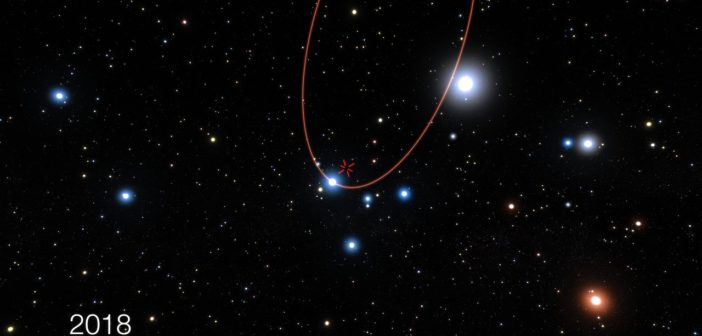Editor’s note: Astrobites is a graduate-student-run organization that digests astrophysical literature for undergraduate students. As part of the partnership between the AAS and astrobites, we repost astrobites content here at AAS Nova once a week. We hope you enjoy this post from astrobites; the original can be viewed at astrobites.org!
Title: Investigating the Binarity of S0-2: Implications for its Origins and Robustness as a Probe of the Laws of Gravity around a Supermassive Black Hole
Authors: D. S. Chu, T. Do, A. Hees, A. Ghez, et al.
First Author’s Institution: University of California, Los Angeles
Status: Submitted to ApJ, open access
The most exciting discoveries in astronomy all have something in common: they let us marvel at the fact that nature obeys laws of physics. The star S0-2 is one of these exciting discoveries. S0-2 (also known as S2) is a fast-moving star that has been observed to follow a full elliptical, 16-year orbit around the Milky Way’s central supermassive black hole, precisely according to Kepler’s laws of planetary motion. Serving as a test-particle probe of the gravitational potential, S0-2 provides some of the best constraints on the black hole’s mass and distance yet. S0-2 is the brightest of the S-stars, a group of young main-sequence stars concentrated within the inner 1” (0.13 ly) of the nuclear star cluster.
The next time S0-2 reaches its closest approach to the black hole, in 2018, there will exist a unique opportunity to detect a deviation from Keplerian motion — namely the relativistic redshift of S0-2’s radial (line-of-sight) velocity — in a direct measurement. In anticipation of this event, the authors of today’s paper investigate possible consequences of S0-2 being not a single star, but a spectroscopic binary, which would complicate this measurement.

Figure 1: Top: Radial velocity measurements of S0-2 over time. Bottom: Residual velocities after subtraction of the best-fit model for the orbital motion. [Chu et al. 2017]

Figure 2: Lomb-Scargle periodogram of S0-2’s residual radial velocity curve (see Fig. 1). No peak reaches the 95% confidence level, which implies that no statistically significant signature of a periodic variation is found in the observations. [Chu et al. 2017]
However, this non-detection of a periodic signal places an upper limit on the radial velocity variations that could be caused by a possible companion of S0-2, which can be converted into a mass limit. For instance, at a period of 100 days, velocity changes larger than about 12 km/s would have been confidently detected. This implies a companion mass smaller than about 1.7 solar masses, assuming a reasonable total mass of the binary in the range of 14.1 to 20 solar masses.
To estimate the effect of such a companion on the prospective measurement of the relativistic redshift, the authors simulate observations of S0-2 extending into 2018, using a relativistic orbit model and assuming that S0-2 is in fact a binary. These data sets are then fit in the same way as the real data would normally be, using a model in which S0-2 is assumed to be a single star and the strength of the expected relativistic effect is described by a free parameter. The authors conclude that even if S0-2 is a binary, the relativistic redshift could still be detected with high statistical significance in 2018, although the measurement could come out slightly biased, depending on the specific configuration of the binary system (Figure 3).

Figure 3: The bias in estimating the parameter describing the strength of the relativistic redshift, if S0-2 is a binary but assumed to be a single star, for different realizations of plausible binary configurations. Shown are deviations from the expected value of this parameter in general relativity, which is 1, where for a Keplerian orbit it is 0. [Chu et al. 2017]
About the author, Philipp Plewa:
I am currently a graduate student at the Max-Planck-Institute for Extraterrestrial Physics in Germany. My main interest is in developing new tools for high-precision infrared astrometry, with the aim of learning more about the supermassive black hole at the center of the Milky Way and the stars in its vicinity.

3 Comments
Pingback: Is S0-2 binary?
Pingback: Rasender Stern bereit für präzisen Test der Allgemeinen Relativitätstheorie - Abenteuer Astronomie
Pingback: Weitere Artikel dieses Bloggers von eben u.a. | Skyweek Zwei Punkt Null